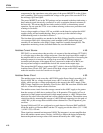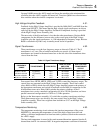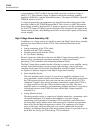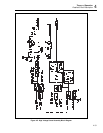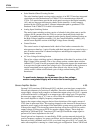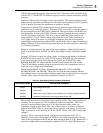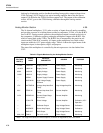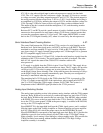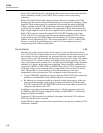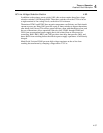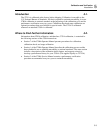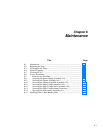
5725A
Instruction Manual
4-36
Relays K102 and K103 provide switching that allows direct drive of the sense amplifier
and its calibration circuitry by the 5700A. These switches are used only during
calibration.
Relays K105 and K109 are high voltage reed relays that provide output to the 5700A
binding posts and remote sensing from the binding posts, respectively, during ac voltage
operation. These connections are accomplished by connecting the output of the High
Voltage Amplifier to B-OUT HI and the input of the sense amplifier to B-SENSE HI.
Local sensing for standby and calibration is accomplished by K104, which enables the
High Voltage Amplifier to drive the sense amplifier and its calibration circuitry directly.
While 5700A current is sourced through the 5725A OUTPUT binding posts of the
5725A, relay K151 is energized to provide current guarding within the 5725A. 5700A
output current comes to the High Voltage Sense assembly via J101 and is routed to a
guarded coaxial cable through J152. The current return path is via E155. While 5700A
current is sourced at its own binding posts, relay K151 is de-energized to prevent
compromising of the 5700A internal guard.
Control Section 4-59.
The relay and switch control section consists simply of a pair of latched relay drivers,
U157 and U158. Each of these latches receives its input from the microprocessor bus and
drives a bank of relays. Additionally, the microprocessor has a ready means to quickly
open all relays via a CLR signal that synchronously clears the driver latches. The outputs
of relay driver U157 control six relays on the High Voltage Sense assembly (A6), four
relays on the Interconnect assembly (A1), and four relays on the High Voltage Amplifier
assembly (A3). Relays on the Interconnect and High Voltage Amplifier assemblies are
controlled via HFPD, VLFPD, LFPD, and MFPD. Relay driver U158 is unique because
all the high voltage relays connected directly to the outside world are driven from this
latch. This provides a way for hardware to clear the instrument to a safe state
independently of the microprocessor. This can happen in the following two ways:
• Via the CABLEOFF signal that is asserted when the 5700A/5725A link is physically
disabled as described under "Serial Interface/Guard Crossing Section".
• By detecting an overcurrent condition in the high voltage power supply, which not
only shuts down the high voltage supply, but also clears latch U158 via the signal
HVCLR. Note that HVCLR, CABLEOFF, and CLR are diode-OR’ed to provide the
composite clear function for U158.
In addition to controlling all the high voltage relays, U158 also generates control line
CLAMPD for the High Voltage Amplifier assembly, and HVSUPPLY* for the Power
Supply and Digital assemblies.
Comparator U150A provides level shifting of the output of the latch U158 so that the
JFET switch Q104 can be controlled.
Switch SW150 is simply a contact closure that indicates to the processor whether 5725A
calibration is enabled.



